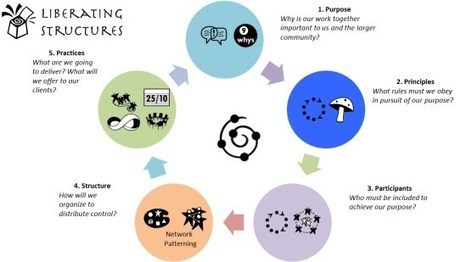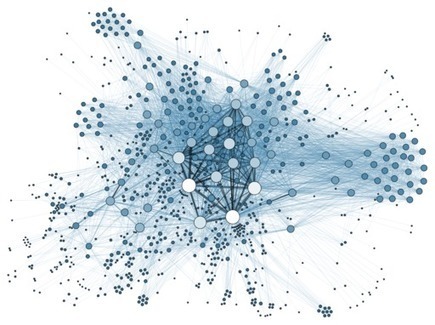 Your new post is loading...
 Your new post is loading...
Worth a read! "Third, we’re seeing the spontaneous rise of collaborative production: goods, services and organisations are appearing that no longer respond to the dictates of the market and the managerial hierarchy. The biggest information product in the world – Wikipedia – is made by volunteers for free, abolishing the encyclopedia business and depriving the advertising industry of an estimated $3bn a year in revenue.
Almost unnoticed, in the niches and hollows of the market system, whole swaths of economic life are beginning to move to a different rhythm. Parallel currencies, time banks, cooperatives and self-managed spaces have proliferated, barely noticed by the economics profession, and often as a direct result of the shattering of the old structures in the post-2008 crisis.
You only find this new economy if you look hard for it. In Greece, when a grassroots NGO mapped the country’s food co-ops, alternative producers, parallel currencies and local exchange systems they found more than 70 substantive projects and hundreds of smaller initiatives ranging from squats to carpools to free kindergartens
Via june holley

|
Scooped by
Liz Rykert
April 19, 2017 8:32 AM
|
It takes a concentrated effort, but it’s good for the organization.

|
Rescooped by
Liz Rykert
from Network Leadership
February 26, 2017 6:22 AM
|
What's the secret to unlocking the creativity hidden inside your daily work, and giving every great idea a chance? Harvard professor Linda Hill, co-author of "Collective Genius," has studied some of the world's most creative companies to come up with a set of tools and tactics to keep great ideas flowing -- from everyone in the company, not just the designated "creatives."
Via june holley

|
Scooped by
Liz Rykert
February 24, 2017 7:20 AM
|
In one of the classes I teach at CCA, students were confused by mental models, conceptual models, concept maps, etc. I ended up drawing a taxonomy for models on the whiteboard, and it may help others…

|
Scooped by
Liz Rykert
February 23, 2017 12:53 PM
|
The definitive set of open-source tools to design digital and non-digital platforms with ease. Learn today how to shape a market and access ecosystems!
As readers of my blog may have noticed, I've mentioned Liberating Structures more and more over the past two years. I've used them extensively with clients, but
Via june holley

|
Rescooped by
Liz Rykert
from Papers
January 17, 2017 11:06 AM
|
A characteristic property of networks is their ability to propagate
influences, such as infectious diseases, behavioral changes, and failures. An
especially important class of such contagious dynamics is that of cascading
processes. These processes include, for example, cascading failures in
infrastructure systems, extinctions cascades in ecological networks, and
information cascades in social systems. In this review, we discuss recent
progress and challenges associated with the modeling, prediction, detection,
and control of cascades in networks. The Unfolding and Control of Network Cascades,
Adilson E. Motter and Yang Yang,
Physics Today, January 2017, page 32.
http://physicstoday.scitation.org/doi/10.1063/PT.3.3426
Via Complexity Digest

|
Scooped by
Liz Rykert
January 8, 2017 9:21 AM
|
An inspiring quote is a great tool for changing a mindset. I made a personal collection of 50 outstanding quotes on change and innovation. Use them to inspire others to start a culture of change, to think different and to prioritize change and innovation at the start of 2017.

|
Scooped by
Liz Rykert
January 6, 2017 1:20 PM
|
The primary shift in the meetings and events industry in 2017 is going to revolve around delivering business events that engage attendees in more multidisciplinary ways. For the last five years, the industry has been focused on two trends impacting meeting design strategy above all else: the rise of event technology and the emergence of the Millennial generation. There was growing consensus in 2016, however, that it’s time for the meetings industry to move beyond its preoccupation with those themes.

|
Rescooped by
Liz Rykert
from networks and network weaving
December 1, 2016 8:00 PM
|
In order to thrive in this new era of uncertainty, nonprofit leaders must harness the power of networks in order to grow their ability to influence the future.
Via june holley

|
Scooped by
Liz Rykert
November 9, 2016 11:30 AM
|
Phil Willburn describes the insights gained at the Center for Creative Leadership's 2014 Thought Forum on Network Leadership and Leadership Networks.

|
Rescooped by
Liz Rykert
from networks and network weaving
November 6, 2016 6:49 PM
|
“The goal is not so much to see that which no one has seen, but to see that which everyone else sees in a totally different way.” – Arthur Schopenhauer I just finished reading The…
Via june holley
|

|
Rescooped by
Liz Rykert
from CxConferences
October 3, 2017 10:22 PM
|
Place & Date: 9am – 4:30pm, Nov 14th, 2017 at Clark Center S360, Stanford University.
Registration link: https://goo.gl/forms/rfb9S4jNQmsuKetf1
There will be three focusing questions for the Symposium:
What is “Complexity Science”?
How is Complexity Science integrated into various disciplines?
How does Complexity Science affect how we solve scientific, social, or philosophical problems?
All proceedings of the Symposium will be professionally video recorded and uploaded to our Youtube account, https://www.youtube.com/user/StanfordComplexity
Via Complexity Digest

|
Rescooped by
Liz Rykert
from Network Leadership
February 26, 2017 6:22 AM
|
Think like a network, act like a node. At IISC, we continue to emphasize that networks, not organizations, are the unit of social change. Part of the reason for this is that networks at their best …
Via june holley

|
Scooped by
Liz Rykert
February 23, 2017 1:06 PM
|

|
Rescooped by
Liz Rykert
from CxBooks
February 17, 2017 7:52 AM
|
Big data, genomics, and quantitative approaches to network-based analysis are combining to advance the frontiers of medicine as never before. Network Medicine introduces this rapidly evolving field of medical research, which promises to revolutionize the diagnosis and treatment of human diseases. With contributions from leading experts that highlight the necessity of a team-based approach in network medicine, this definitive volume provides readers with a state-of-the-art synthesis of the progress being made and the challenges that remain. Medical researchers have long sought to identify single molecular defects that cause diseases, with the goal of developing silver-bullet therapies to treat them. But this paradigm overlooks the inherent complexity of human diseases and has often led to treatments that are inadequate or fraught with adverse side effects. Rather than trying to force disease pathogenesis into a reductionist model, network medicine embraces the complexity of multiple influences on disease and relies on many different types of networks: from the cellular-molecular level of protein-protein interactions to correlational studies of gene expression in biological samples. The authors offer a systematic approach to understanding complex diseases while explaining network medicine’s unique features, including the application of modern genomics technologies, biostatistics and bioinformatics, and dynamic systems analysis of complex molecular networks in an integrative context. By developing techniques and technologies that comprehensively assess genetic variation, cellular metabolism, and protein function, network medicine is opening up new vistas for uncovering causes and identifying cures of disease.
Via Complexity Digest
Mapping Networks & Systems to Support Social Innovation. Social change network weaver support & organizational services. Christine Capra, Tim Hanson, MN
Via june holley

|
Rescooped by
Liz Rykert
from Papers
January 17, 2017 11:05 AM
|
This article describes the themes found in the past 25 years of creativity research. Computational methods and network analysis were used to map keyword theme development across ~1,400 documents and ~5,000 unique keywords from 1990 (the first year keywords are available in Web of Science) to 2015. Mapping the Themes, Impact, and Cohesion of Creativity Research over the Last 25 Years
Rich Williams, Mark A. Runco & Eric Berlow
Creativity Research Journal.Volume 28, 2016 - Issue 4 Pages 385-394 | Published online: 14 Nov 2016
Via Complexity Digest

|
Rescooped by
Liz Rykert
from networks and network weaving
January 6, 2017 1:30 PM
|
Applying network theory to medieval records suggests that historical events are governed by “laws of history,” just as nature is bound by the laws of physics.
Via june holley

|
Scooped by
Liz Rykert
December 28, 2016 5:45 PM
|
A combined list with some of the most influential and revolutionary profiles in the industry with interesting facts, summary of their work and much more.

|
Rescooped by
Liz Rykert
from Papers
December 3, 2016 9:07 PM
|
Nearly all nontrivial real-world systems are nonlinear dynamical systems. Chaos describes certain nonlinear dynamical systems that have a very sensitive dependence on initial conditions. Chaotic systems are always deterministic and may be very simple, yet they produce completely unpredictable and divergent behavior. Systems of nonlinear equations are difficult to solve analytically, and scientists have relied heavily on visual and qualitative approaches to discover and analyze the dynamics of nonlinearity. Indeed, few fields have drawn as heavily from visualization methods for their seminal innovations: from strange attractors, to bifurcation diagrams, to cobweb plots, to phase diagrams and embedding. Although the social sciences are increasingly studying these types of systems, seminal concepts remain murky or loosely adopted. This article has three aims. First, it argues for several visualization methods to critically analyze and understand the behavior of nonlinear dynamical systems. Second, it uses these visualizations to introduce the foundations of nonlinear dynamics, chaos, fractals, self-similarity and the limits of prediction. Finally, it presents Pynamical, an open-source Python package to easily visualize and explore nonlinear dynamical systems’ behavior. Visual Analysis of Nonlinear Dynamical Systems: Chaos, Fractals, Self-Similarity and the Limits of Prediction
Geoff Boeing Systems 2016, 4(4), 37; doi:10.3390/systems4040037
Via Complexity Digest

|
Scooped by
Liz Rykert
November 9, 2016 11:33 AM
|
“Network entrepreneurs are keenly aware that they are few among many working across the larger system, and in this way they embody a special type of … leader[ship].” – Jane …

|
Scooped by
Liz Rykert
November 9, 2016 11:28 AM
|
The Center for Ethical Leadership is a national nonprofit that cultivates leadership and change capacity that advances social change. We support individual, institutional an
|



 Your new post is loading...
Your new post is loading...































